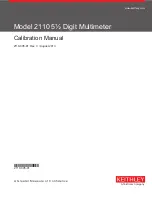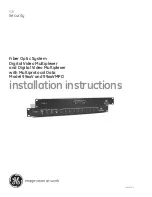
DM16E1 / DM4E1 Operation and Installation Manual - 204-4001-19
30
•
2048kHz E1 AIS Reference: Used in the event of data loss in an aggregate link. This loss must
be signaled to the tributaries according to the G.742/G.751 recommendations. It is possible to set
which clock reference will be used to emit AIS to the tributaries when this condition occurs.
Options are:
−
Internal: Uses the local clock reference.
−
External: Uses the external clock reference, which is accessible on the rear panel of the
device. If this clock fails, the equipment will automatically switch to the internal clock
reference.
•
Aggregate Backup: Used as backup to the equipment. In the descriptions that follow, the
aggregate interface set up as MAIN is referred to as the main link. The same applies to the
backup interface. Options are:
−
Disable: Backup is disabled, and use of the main link is mandatory. The equipment will
ignore possible errors in aggregate interfaces.
−
Automatic: Backup is enabled. The equipment will use the backup link if necessary. If no
backup interfaces are present, the equipment will indicate failure in case of loss of the
main link. This option enforces the Backup Enter Time and Backup Return Time defined
below.
−
Semi-Automatic: Backup is enabled. The equipment will use the backup link if
necessary. If no backup interfaces are present, the equipment will indicate failure in case
of loss of the main link. This option enforces the Backup Enter Time and Backup Return
Time defined below. Additionally, a recognition signal is needed so that the equipment
goes back to the main link once the Backup Return Time is reached. See menu Status /
Equip.
−
Forced Using Backup, Forced Using Ring Backup, Forced Generating Ring Backup,
Forced Forwarding Ring Data: These values are used to force the equipment to behave
as if it were using the backup link.
•
Backup Enter Time, Backup Return Time: These times are used to define how long the main link
should be in LOS condition to be considered an inappropriate link and how long after the main
link is synchronized it may be considered reliable, respectively.
•
External Alarm 1, 2 e 3: Individually activate / deactivate external alarm inputs. Options are:
−
Enable: External alarm enabled. This alarm will be part of the equipment alarm logic.
Any changes in the conditions of this alarm will be notified to the management system
(terminal or SNMP).
−
Disable: External alarm disabled. This alarm will be ignored in the equipment alarm
logic. Any changes in conditions of this alarm will not be notified to the management
system (terminal or SNMP).
•
Alarm Output Activity Time: Indicates the time during which the alarm relay will remain active in
case of failure. The Disable value means it will be not enabled, and Forever will keep the output
always active in case of an alarm event. The time range is configurable between 1 s and 24 h.
•
Alarm Output Frequency: Time after which the external alarm output is activated after Alarm
Output Activity Time starts counting. The Instantaneous value reactivates the relay right after the
end of the period, and Infinity means the activation period will not repeat. The time range is
configurable between 1 s and 24 h.
















































